Seismic Data Interpretation and Petrophysical Analysis of Kabirwala Area Tola (01) Well, Central Indus Basin, Pakistan
Abstract
1. Introduction
2. Tectonics of the Area
3. Generalized Stratigraphy of the Area
3.1. Pliocene/Miocene Stratigraphy
3.1.1. Nagri Formation
3.1.2. Chinji Formation
3.2. Oligocene Stratigraphy
Nari Formation
3.3. Eocene Stratigraphy
3.3.1. Habib Rahi Formation
3.3.2. Pirkoh Formation
3.4. Paleocene Stratigraphy
3.4.1. Ghazij Sui Member
3.4.2. Dunghan Formation
3.4.3. Ranikot Formation
3.5. Cretaceous Stratigraphy
3.5.1. Sembar Formation
3.5.2. Goru Formation
3.5.3. Parh Limestone
3.5.4. Moghal Kot Formation
3.5.5. Pab Sandstone
3.6. Jurassic Stratigraphy
3.6.1. Samana Suk Formation
3.6.2. Shinawri Formation
3.6.3. Datta Formation
3.7. Triassic Stratigraphy
3.7.1. Kingriali Formation
3.7.2. Tredian Formation
3.8. Permian Stratigraphy
3.8.1. Amb Formation
3.8.2. Sardhai Formation
3.8.3. Warcha Formation
4. Seismic Data Interpretation
4.1. Seismic Time and Depth Sections
4.2. Marking Reflectors
4.3. Time and Depth Contour Maps and Surfaces Maps
4.3.1. Time Contour Maps
4.3.2. Depth Contour Maps
4.4. Time Contour and Time Surfaces Maps of Dunghan Formation
4.5. Time Contour and Time Surfaces Maps of Samana Suk Formation
4.6. Time Contour and Time Surfaces Maps of Datta Formation
4.7. Time Contour and Time Surfaces Maps of Warcha Formation
4.8. Depth Contour and Depth Surfaces Maps of Dunghan Formation
4.9. Depth Contour and Depth Surfaces Maps of Samana Suk Formation
4.10. Depth Contour and Depth Surfaces Maps of Datta Formation
4.11. Depth Contour and Depth Surfaces Maps of Warcha Formation
5. Petrophysical Analysis
5.1. Calculation of Volume of Shale
5.2. Total Porosity
5.3. Neutron Porosity
Density Porosity
5.4. Effective Porosity
5.5. Saturation of Water
5.6. Saturation of Hydrocarbon
6. Discussion
7. Conclusions
- The seismic data interpretation confirms that normal faults with horst and graben structures are favorable for the accumulation of hydrocarbons.
- The high zone present in the northwestern part of the contour maps could be a possible location of hydrocarbon entrapment, which is further confirmed by the presence of the Tola01 well.
- For the marked zone of interest, the average water saturation is 18%, average total porosity is 27.8%, average effective porosity is 8.2%, and net pay thickness is 84.14 m.
- The time section confirms that the formations are shallower in the northwestern direction and deeper along the southeastern direction. The stratigraphic conditions of these Jurassic age formations led to a complete petroleum system in the area.
- As a limitation, the current study needs further and suitable calibration with more actual well data to prove reliability and efficiency.
- In the future, we will implement 3D seismic data interpretation in the proposed field of our research. Similarly, we will also attempt to use the inversion algorithm for further exploration to obtain rich information.
Author Contributions
Funding
Institutional Review Board Statement
Informed Consent Statement
Data Availability Statement
Acknowledgments
Conflicts of Interest
References
- Li, J.-Y.; Chen, X.; Hao, Z.-J.; Rui, Z.-H. A Study on Multiple Time-Lapse Seismic AVO Inversion. Chin. J. Geophys. 2005, 48, 974–981. [Google Scholar] [CrossRef]
- Ou, C.; Li, C.; Rui, Z.; Ma, Q. Lithofacies distribution and gas-controlling characteristics of the Wufeng–Longmaxi black shales in the southeastern region of the Sichuan Basin, China. J. Pet. Sci. Eng. 2018, 165, 269–283. [Google Scholar] [CrossRef]
- Al-Shuhail, A.A.; Alshuhail, A.A.; Khulief, Y.A.; Salam, S.A.; Chan, S.A.; Ashadi, A.L.; Al-Lehyani, A.F.; Almubarak, A.M.; Khan, M.Z.U.; Khan, S.; et al. KFUPM Ghawar digital viscoelastic seismic model. Arab. J. Geosci. 2019, 12, 245. [Google Scholar] [CrossRef]
- Liu, Y.; Chen, S.; Guan, B.; Xu, P. Layout optimization of large-scale oil–gas gathering system based on combined optimization strategy. Neurocomputing 2019, 332, 159–183. [Google Scholar] [CrossRef]
- Khan, A.M.; Al-Juhani, S.G.; Abdul, S. Digital viscoelastic seismic models and data sets of central Saudi Arabia in the presence of near-surface karst features. J. Seism. Explor. 2020, 29, 15–28. [Google Scholar]
- Khan, S.; Khulief, Y.A.; Al-Shuhail, A. Mitigating climate change via CO2 sequestration into Biyadh reservoir: Geomechanical modeling and caprock integrity. Mitig. Adapt. Strat. Glob. Chang. 2018, 24, 23–52. [Google Scholar] [CrossRef]
- Khan, S.; Al-Shuhail, A.A.; Khulief, Y.A.; Al-Shuhail, A. Numerical modeling of the geomechanical behavior of Ghawar Arab-D carbonate petroleum reservoir undergoing CO2 injection. Environ. Earth Sci. 2016, 75, 1499. [Google Scholar] [CrossRef]
- Khan, S.; Khulief, Y.; Al Shuhail, A. The effect of injection well arrangement on CO2 injection into carbonate petroleum reservoir. Int. J. Glob. Warm. 2018, 14, 462. [Google Scholar] [CrossRef]
- Khan, S.; Khulief, Y.A.; Al-Shuhail, A.A.; Al-Shuhail, A. Numerical Modeling of the Geomechanical Behavior of Biyadh Reservoir Undergoing CO2 Injection. Int. J. Géomeéch. 2017, 17, 04017039. [Google Scholar] [CrossRef]
- Das, B.; Chatterjee, R. Well log data analysis for lithology and fluid identification in Krishna-Godavari Basin, India. Arab. J. Geosci. 2018, 11, 231. [Google Scholar] [CrossRef]
- Fajana, A.O.; Ayuk, M.A.; Enikanselu, P.A.; Oyebamiji, A.R. Seismic interpretation and petrophysical analysis for hydrocarbon resource evaluation of ‘Pennay’ field, Niger Delta. J. Pet. Explor. Prod. Technol. 2018, 9, 1025–1040. [Google Scholar] [CrossRef]
- Grana, D.; Della Rossa, E. Probabilistic petrophysical-properties estimation integrating statistical rock physics with seismic inversion. Geophysics 2010, 75, O21–O37. [Google Scholar] [CrossRef]
- Zhang, B.; Zhao, T.; Jin, X.; Marfurt, K.J. Brittleness evaluation of resource plays by integrating petrophysical and seismic data analysis. Interpretation 2015, 3, T81–T92. [Google Scholar] [CrossRef]
- Grijalba-Cuenca, A.; Torres-Verdin, C.; van der Made, P. Geostatistical inversion of 3D seismic data to extrapolate wireline petrophysical variables laterally away from the well. In Proceedings of the SPE Annual Technical Conference and Exhibition, Society of Petroleum Engineers, Dallas, TX, USA, 1–4 October 2000. [Google Scholar]
- Sanuade, O.A.; Akanji, A.O.; Olaojo, A.A.; Oyeyemi, K.D. Seismic interpretation and petrophysical evaluation of SH field, Niger Delta. J. Pet. Explor. Prod. Technol. 2018, 8, 51–60. [Google Scholar] [CrossRef]
- Nwaezeapu, V.C.; Ezenwaka, K.C.; Ede, T.A. Evaluation of hydrocarbon reserves using integrated petrophysical analysis and seismic interpretation: A case study of TIM field at southwestern offshore Niger Delta oil Province, Nigeria. Egypt. J. Pet. 2019, 28, 273–280. [Google Scholar] [CrossRef]
- Shah, S.B.A.; Abdullah, W.H. Structural interpretation and hydrocarbon potential of Balkassar oil field, eastern Potwar, Pakistan, using seismic 2D data and petrophysical analysis. J. Geol. Soc. India 2017, 90, 323–328. [Google Scholar] [CrossRef]
- Zahid, M.; Khan, A.; ur Rashid, M.; Saboor, A.; Ahmad, S. Structural interpretation of Joya Mair oil field, south Potwar, Upper Indus Basin, Pakistan, using 2D seismic data and petrophysical analysis. J. Himal. Earth Sci. 2014, 47, 73. [Google Scholar]
- Adeoti, L.; Onyekachi, N.; Olatinsu, O.; Fatoba, J.; Bello, M. Static Reservoir Modeling Using Well Log and 3-D Seismic Data in a KN Field, Offshore Niger Delta, Nigeria. Int. J. Geosci. 2014, 5, 93–106. [Google Scholar] [CrossRef]
- Aadil, N.; Sohail, G.M. 3D geological modeling of Punjab platform, Middle Indus Basin Pakistan through integration of Wireline logs and seismic data. J. Geol. Soc. India 2014, 83, 211–217. [Google Scholar] [CrossRef]
- Khalid, P.; Naeem, M.; Afzal, M.H.; Din, Z.U.; Yasin, Q. Petroleum play analysis, structural and stratigraphic interpretation of cretaceous sequence, Punjab platform, central indus basin, Pakistan. Sci. Int. 2014, 26, 727–778. [Google Scholar]
- Khokhar, Q.D.; Hakro, A.; Solangi, S.H.; Siddiqui, I.; Abbasi, S.A. Textural Evaluation of Nari Formation, Laki Range, Southern Indus Basin, Pakistan. Sindh Univ. Res. J. 2016, 48. Available online: https://sujo-old.usindh.edu.pk/index.php/SURJ/article/view/2557/2093 (accessed on 25 January 2021).
- Tainsh, H.R.; Stringer, K.V.; Azad, J. Major gas fields of West Pakistan. AAPG Bull. 1959, 43, 2675–2700. [Google Scholar]
- Hemphill, W.R.; Kidwai, A.H. Stratigraphy of the Bannu and Dera Ismail Khan areas, Pakistan; USGS: Reston, VA, USA, 1973. [CrossRef]
- Rehman, S.U.; Riaz, M.A.; Ahmed, M.; Ullah, M.F.; Kashif, M.; Rehman, F. Sedimentology of pir koh formation exposed at Dholi and Rakhi Gaj, Central Sulaiman Range, Pakistan. J. Biol. Environ. Sci. 2017, 11, 224–234. [Google Scholar]
- Wandrey, C.J.; Law, B.E.; Shah, H.A. Sembar Goru/Ghazij Composite Total Petroleum System, Indus and Sulaiman-Kirthar Geologic Provinces, Pakistan and India; US Department of the Interior, US Geological Survey: Reston, VA, USA, 2004.
- Kazmi, A.H. Stratigraphy Of The Dungan Group In Kach-Ziarat Area, NE Balochistan. J. Himal. Earth Sci. 1988, 21, 117–130. [Google Scholar]
- Malkani, M.S. Updated stratigraphy and mineral potential of Sulaiman Basin, Pakistan. Sindh Univ. Res. J.-SURJ 2010, 42. [Google Scholar]
- Hakro, A.D.; Baig, M.A.A. Depositional environment of the Bara formation, fort ranikot area, Sindh. Sindh Univ. Res. J. 2013, 45. Available online: https://sujo-old.usindh.edu.pk/index.php/SURJ/article/view/1640/0 (accessed on 25 January 2021).
- Williams, M.D. Stratigraphy of the Lower Indus Basin, West Pakistan. In Proceedings of the 5th World Petroleum Congress, New York, NY, USA, 30 May–5 June 1959. [Google Scholar]
- Fatmi, A.; Rawson, P. The first Early Cretaceous ammonite faunas from Baluchistan. Cretac. Res. 1993, 14, 91–100. [Google Scholar] [CrossRef]
- Blanford, W.T. 5. On some of the Specific Identifications in Dr. Güther’s Second Report of Collection of Indian Reptiles obtained by the British Museum. J. Zool. 2009, 44, 635–637. [Google Scholar] [CrossRef]
- Eschard, R.; Albouy, E.; Gaumet, F.; Ayub, A. Comparing the depositional architecture of basin floor fans and slope fans in the Pab Sandstone, Maastrichtian, Pakistan. Geol. Soc. Lond. Spéc. Publ. 2004, 222, 159–185. [Google Scholar] [CrossRef]
- Malkani, M.S. Trackways evidence of sauropod dinosaurs confronted by a theropod found from Middle Jurassic Samana Suk Limestone of Pakistan. Sindh Univ. Res. J. 2007, 39, 1–14. [Google Scholar]
- Shah, S.B.A.; Ahmed, A. Hydrocarbon source rock potential of Paleocene and Jurassic deposits in the Panjpir oilfield subsurface, Punjab Platform, Pakistan. Arab. J. Geosci. 2018, 11, 607. [Google Scholar] [CrossRef]
- Iqbal, S.; Jan, I.U.; Akhter, M.G.; Bibi, M. Palaeoenvironmental and sequence stratigraphic analyses of the Jurassic Datta Formation, Salt Range, Pakistan. J. Earth Syst. Sci. 2015, 124, 747–766. [Google Scholar] [CrossRef]
- Abdulghani, A.; Ghazi, S.; Riaz, M.; Zafar, T. Sedimentary Fabrics and Diagenetic Features of the Late Triassic Kingriali Formation, Khisor-Marwat Ranges, Pakistan; NISCAIR-CSIR: New Delhi, India, 2020. [Google Scholar]
- Sarjeant, W.A.S. Acritarchs and Tasmanitids from the Mianwali and Tredian Formations (Triassic) of the Salt and Surghar Ranges, West Pakistan; AAPG: Tulsa, OK, USA, 1973. [Google Scholar]
- Smith, J.J.; Hasiotis, S.T.; Kraus, M.J.; Woody, D.T. Naktodemasis bowni: New ichnogenus and ichnospecies for adhesive meniscate burrows (AMB), and paleoenvironmental implications, Paleogene Willwood Formation, Bighorn Basin, Wyoming. J. Paléontol. 2008, 82, 267–278. [Google Scholar] [CrossRef]
- Jan, I.U.; Stephenson, M.H.; Khan, F.R. Palynostratigraphic correlation of the Sardhai Formation (Permian) of Pakistan. Rev. Palaeobot. Palynol. 2009, 158, 72–82. [Google Scholar] [CrossRef]
- Ullah, K.; Khattak, N.; Qureshi, A.; Akram, M.; Khan, H.; Nisar, A. Search for Uranium Source in Warcha Sandstone, Salt Range, Pakistan, using SSNTD Technique. Radiat. Meas. 2005, 40, 491–495. [Google Scholar] [CrossRef]
- Badley, M.E. Practical Seismic Interpretation by Michael E. Badley. J. Acoust. Soc. Am. 1987, 82, 1100. [Google Scholar] [CrossRef]
- Chopra, S.; Marfurt, K.J. Seismic attributes—A historical perspective. Geophysics 2005, 70, 3SO–28SO. [Google Scholar] [CrossRef]
- Atlas, R.M.; Bartha, R. Hydrocarbon biodegradation and oil spill bioremediation. In Advances in Microbial Ecology; Springer: Berlin/Heidelberg, Germany, 1992; pp. 287–338. [Google Scholar]
- Khan, S.; Khulief, Y.A.; Al-Shuhail, A.A. Alleviation of pore pressure buildup and ground uplift during carbon dioxide injection into Ghawar Arab-D carbonate naturally fractured reservoir. Environ. Earth Sci. 2018, 77, 449. [Google Scholar] [CrossRef]
- Khan, S.; Khulief, Y.A.; Al-Shuhail, A.A. Effects of reservoir size and boundary conditions on pore-pressure buildup and fault reactivation during CO2 injection in deep geological reservoirs. Environ. Earth Sci. 2020, 79, 1–23. [Google Scholar] [CrossRef]
- Khan, S.; Khulief, Y.A.; Al-Shuhail, A.A. Coupled Reservoir-Geomechanical Modeling and Stability Analysis during CO2 Injection into Minjur Sandstone Reservoir. In World Environmental and Water Resources Congress 2018; ASCE: Reston, VA, USA, 2018; pp. 1–13. [Google Scholar]
- Khan, S.; Khulief, Y.; Al-Shuhail, A. Reservoir Geomechanical Modeling and Ground Uplift During CO2 Injection Into Khuff Reservoir. In Proceedings of the Computational Fluid Dynamics; ASME International: New York, NY, USA, 2019; Volume 2, pp. 2–46. [Google Scholar]
- Khan, S.; Khulief, Y.A.; Al-Shuhail, A.A. Reservoir Geomechanical Modeling during CO2 Injection into Deep Qasim Reservoir: A Study Focused on Mitigating Climate Change. In World Environmental and Water Resources Congress 2020: Groundwater, Sustainability, Hydro Climate/Climate Change, and Environmental Engineering; ASCE: Reston, VA, USA, 2020; pp. 29–40. [Google Scholar]
- Quadri, V.-N.; Shuaib, S.M. Hydrocarbon prospects of southern Indus basin, Pakistan. AAPG Bull. 1986, 70, 730–747. [Google Scholar]
- Raza, H.A.; Ahmed, W.; Ali, S.M.; Mujtaba, M.; Alam, S.; Shafeeq, M.; Iqbal, M.; Noor, I.; Riaz, N. Hydrocarbon prospects of Punjab platform Pakistan, with special reference to Bikaner-Nagaur Basin of India. Pak. J. Hydrocarb. Res. 2008, 18, 1–33. [Google Scholar]
- Kadri, I. Petroleum Geology of Pakistan; Pakistan Petroleum Limited: Karachi City, Pakistan, 1995. [Google Scholar]
- Hasany, T.; Aftab, M.; Siddiqui, R.A. Refound exploration opportunities in Infracambrian and Cambrian sediments of Punjab Platform, Pakistan. In Proceedings of the Annual Technical Conference, Islamabad, Pakistan, 27–28 March 2007; pp. 31–62. [Google Scholar]
- Kazmi, A.H.; Jan, M.Q. Geology and Tectonics of Pakistan; Graphic Publishers: Portland, OR, USA, 1997. [Google Scholar]
- Well Logging. Available online: https://gardaerlangga.wordpress.com/2014/07/06/well-logging-definisi-dansejarahnya/ (accessed on 17 January 2021).
- Amosu, A.; Sun, Y. MinInversion: A Program for Petrophysical Composition Analysis of Geophysical Well Log Data. Geosciences 2018, 8, 65. [Google Scholar] [CrossRef]
- Schön, J.H. Physical Properties of Rocks: Fundamentals and Principles of Petrophysics; Elsevier: Amsterdam, The Netherlands, 2015. [Google Scholar]
- De Beer, F.C.; Middleton, M.F.; Hilson, J. Neutron radiography of porous rocks and iron ore. Appl. Radiat. Isot. 2004, 61, 487–495. [Google Scholar] [CrossRef] [PubMed]
- Elkatatny, S.; Mahmoud, M.; Tariq, Z.; Abdulraheem, A. New insights into the prediction of heterogeneous carbonate reservoir permeability from well logs using artificial intelligence network. Neural Comput. Appl. 2017, 30, 2673–2683. [Google Scholar] [CrossRef]
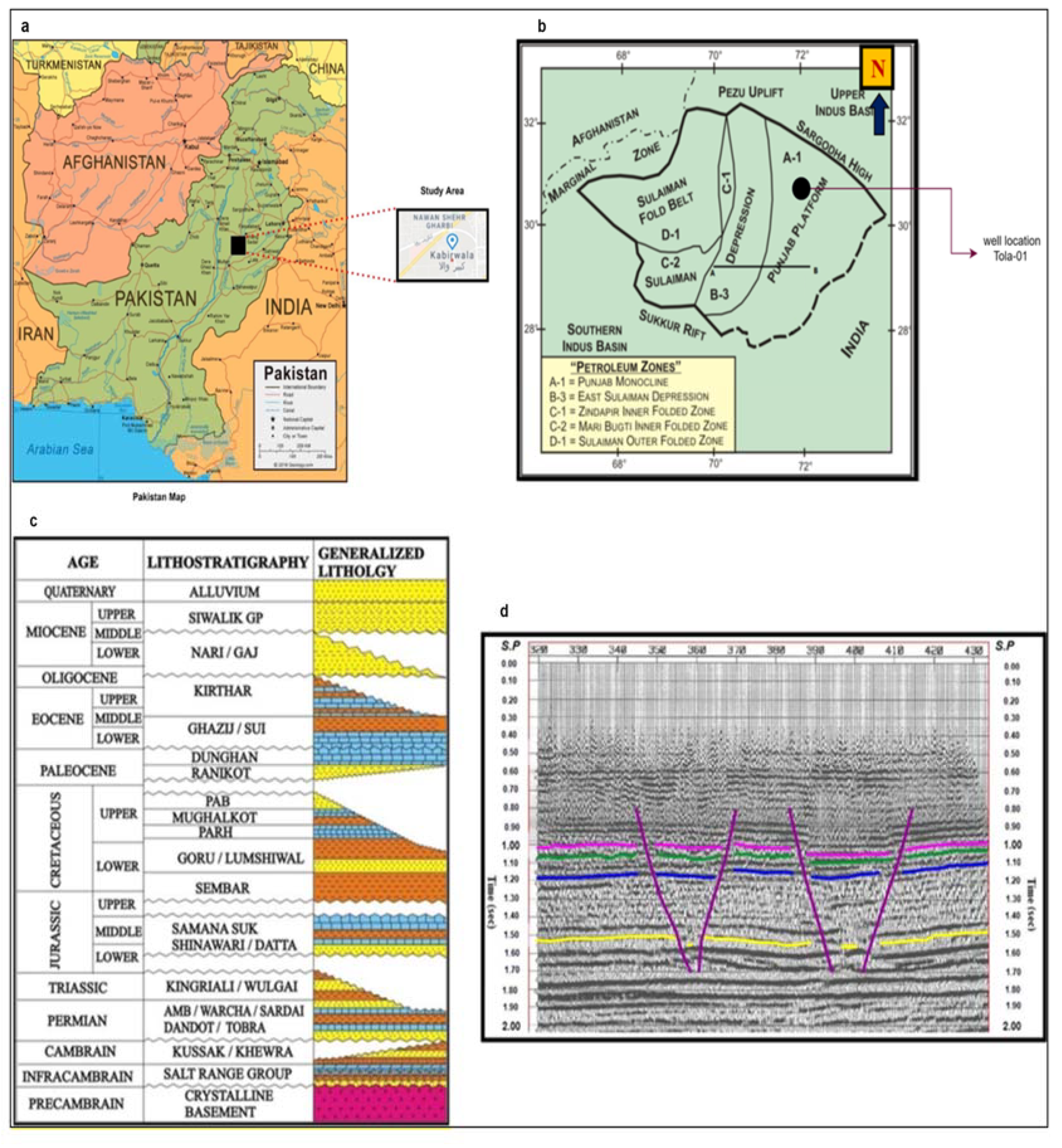



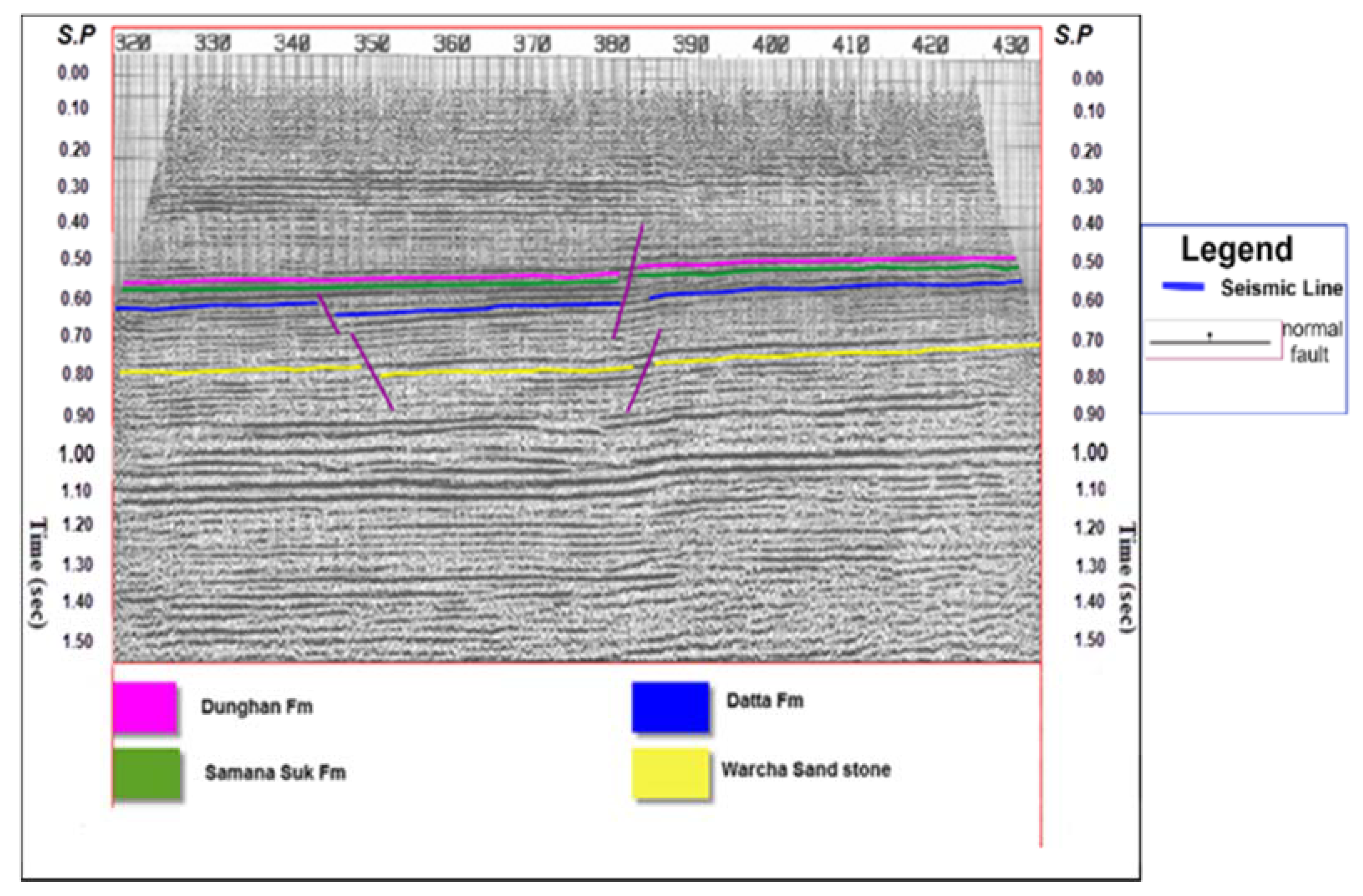
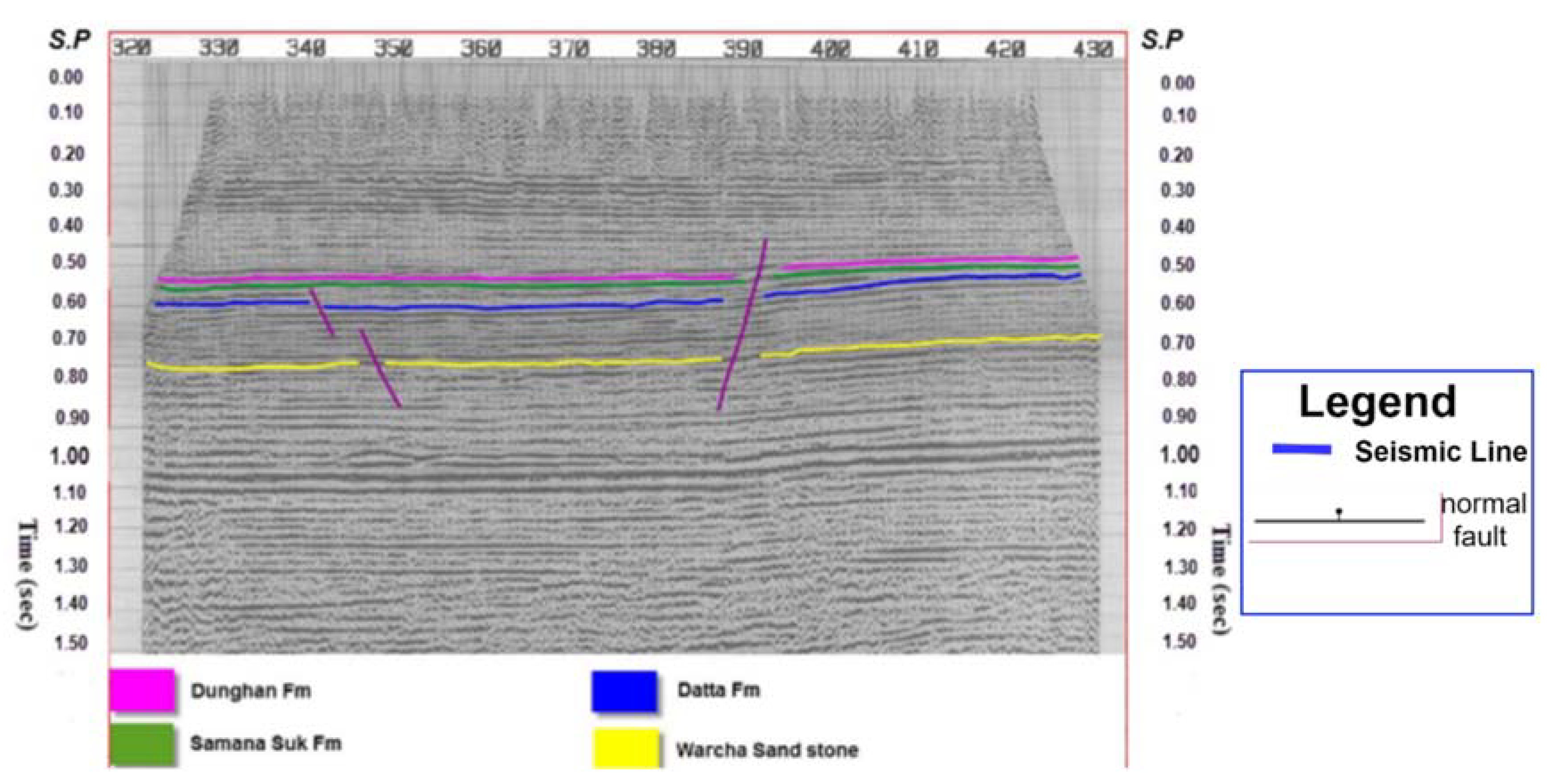
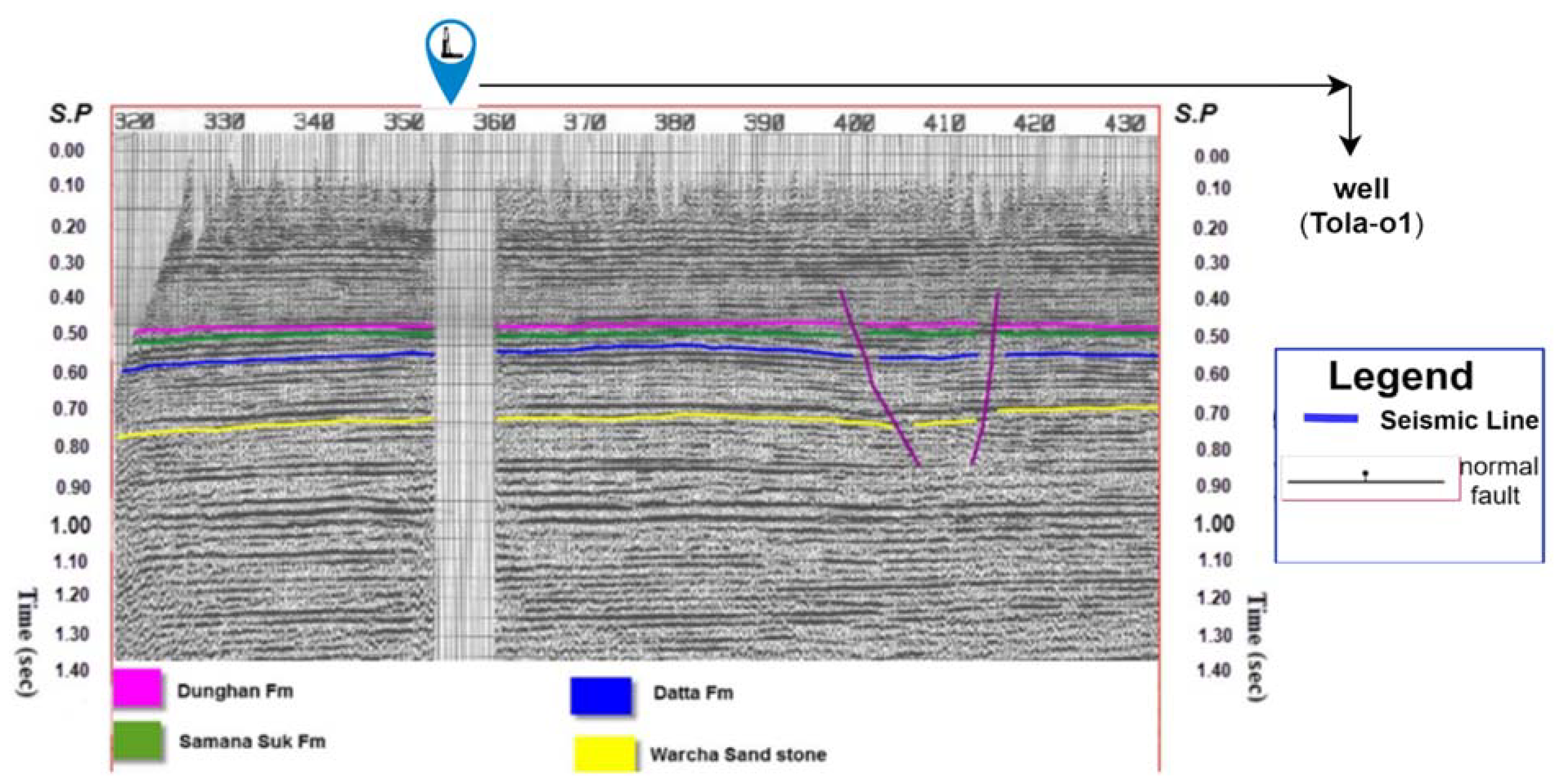
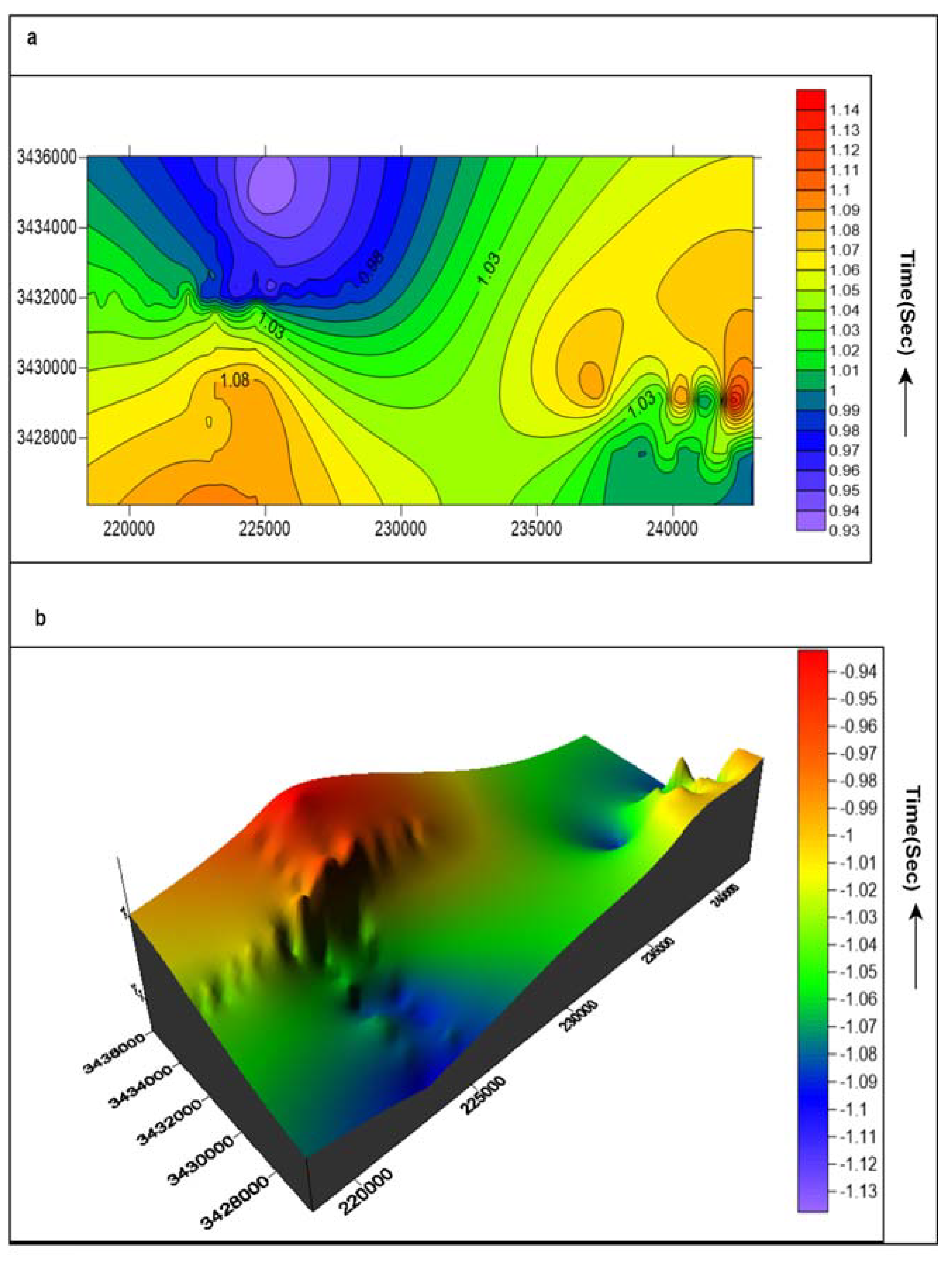
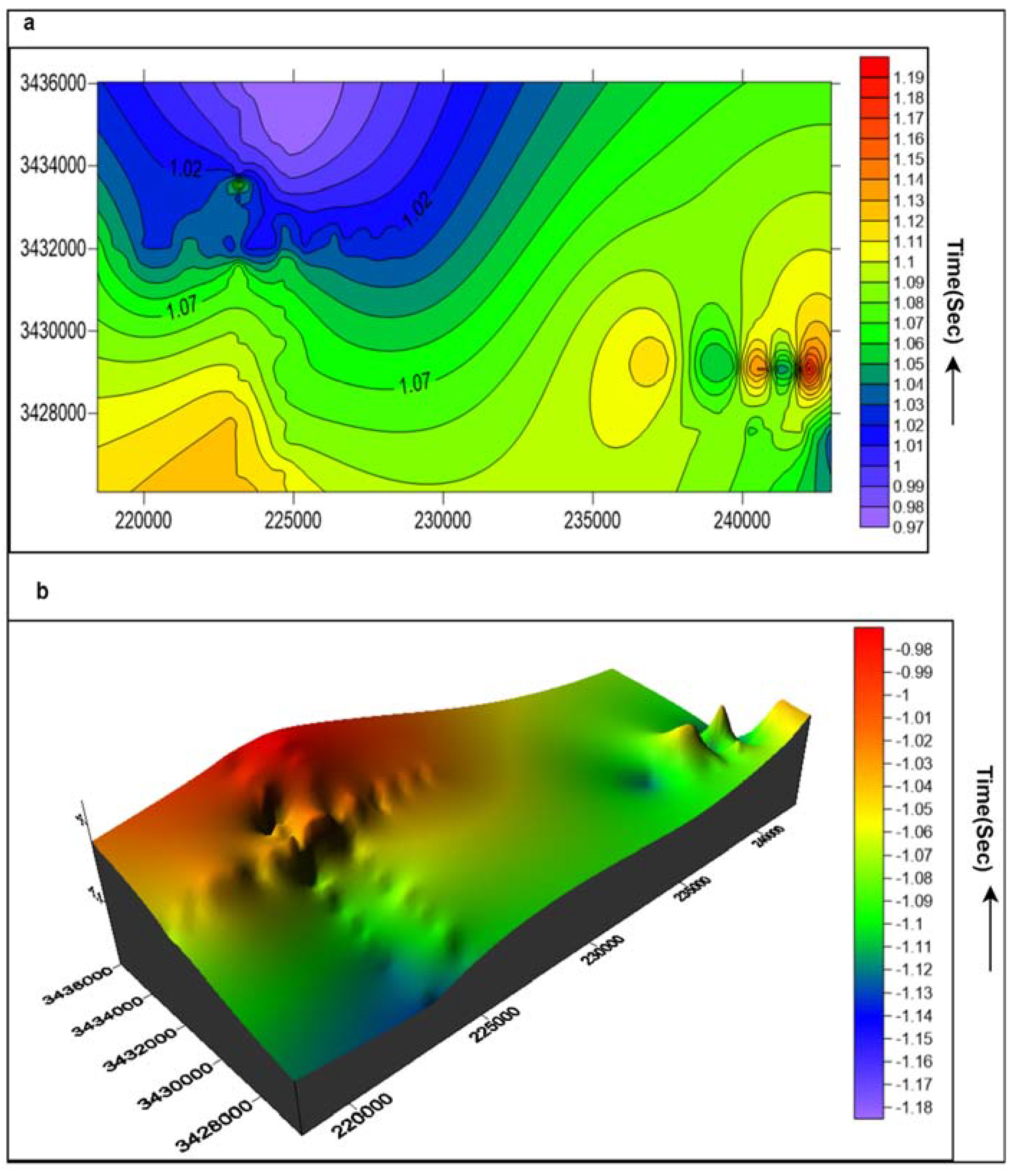

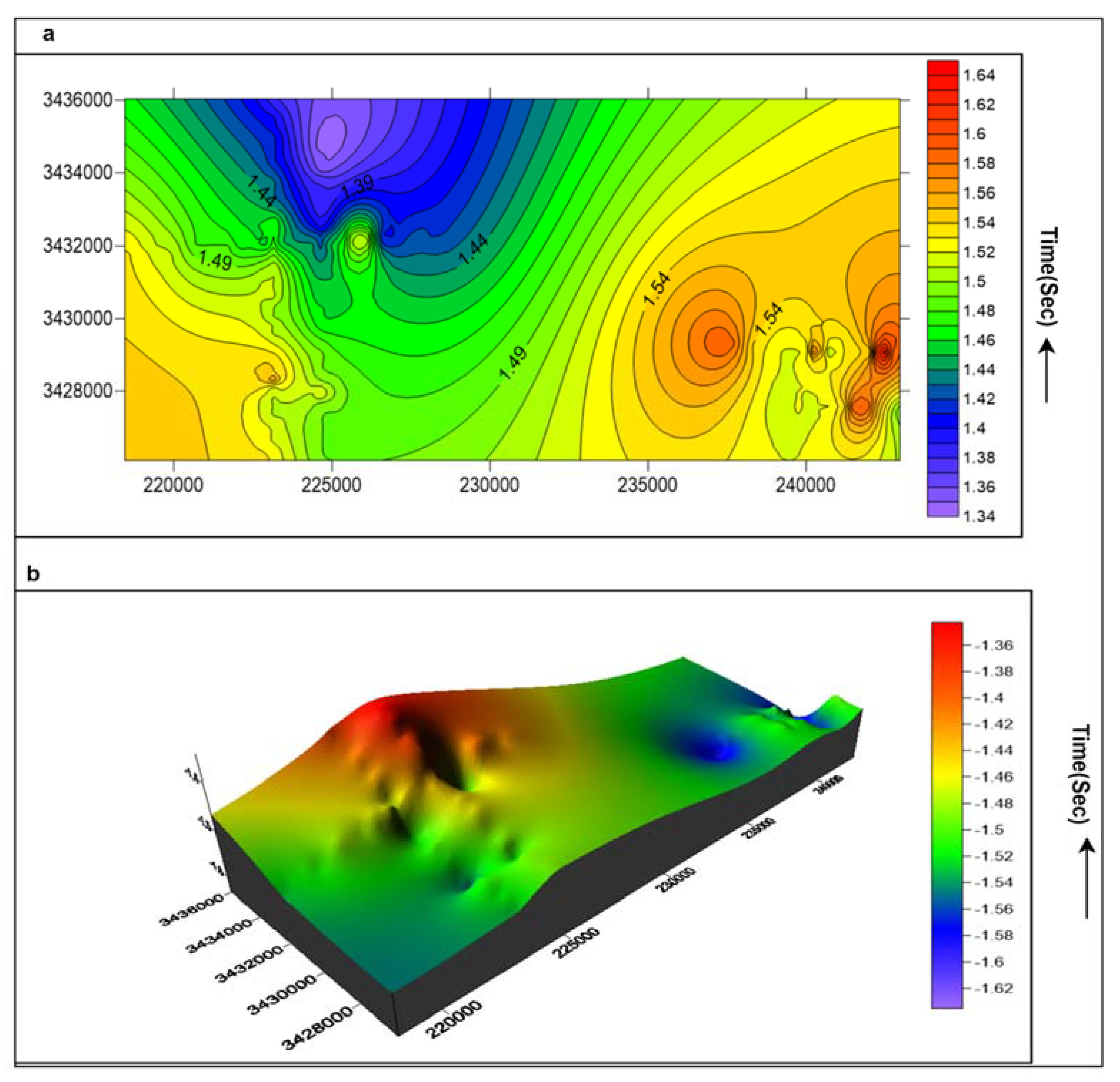
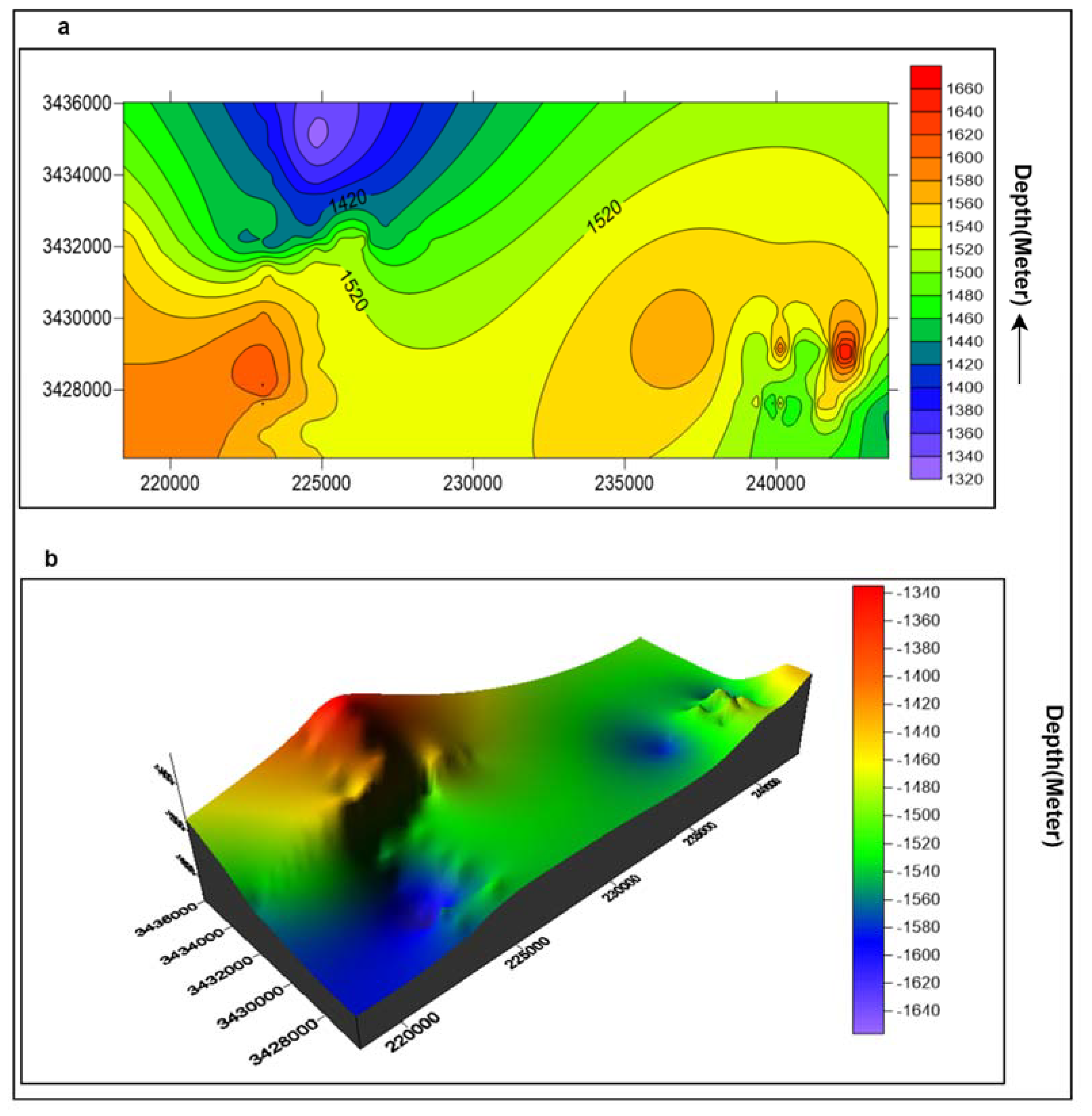
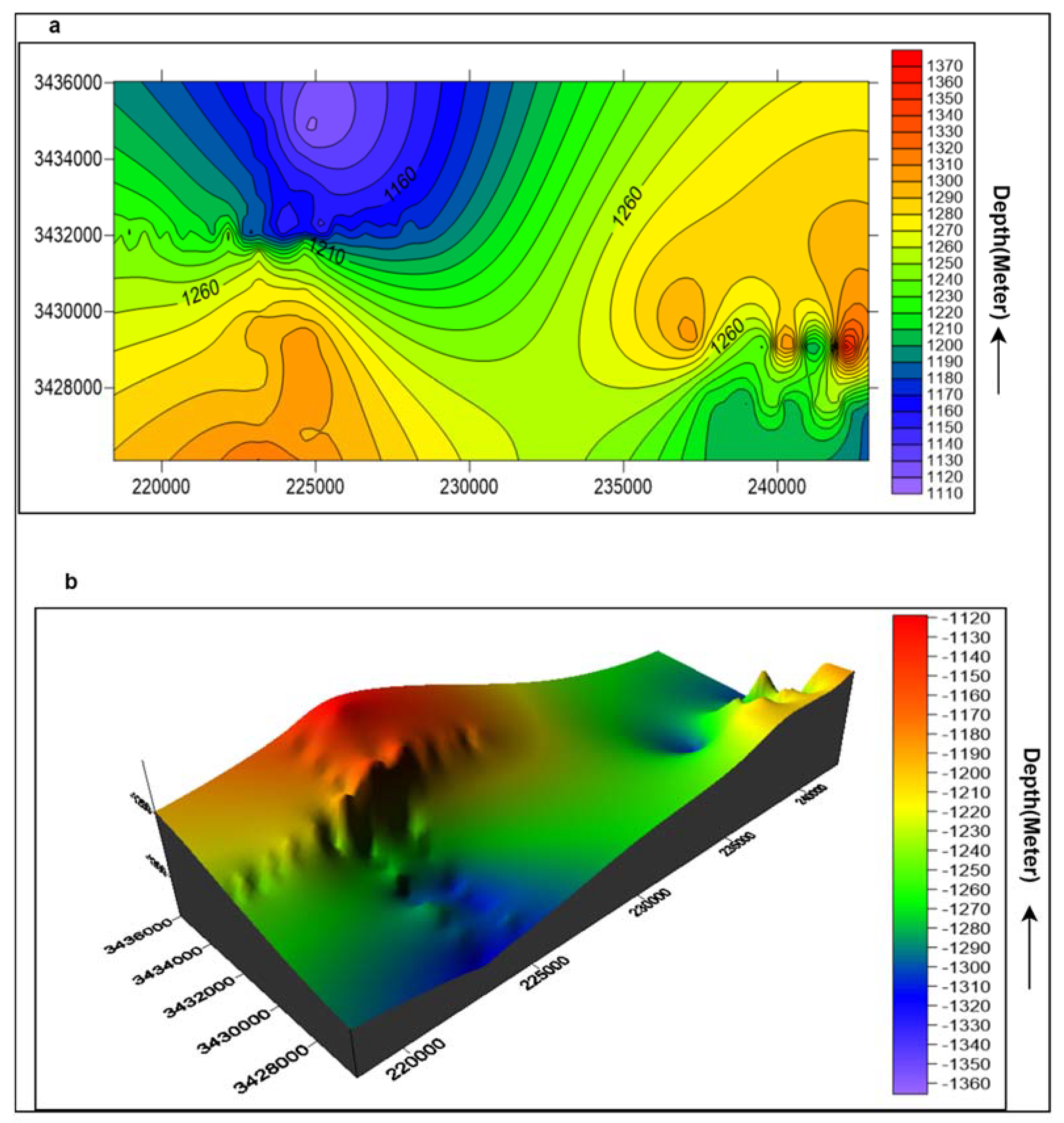

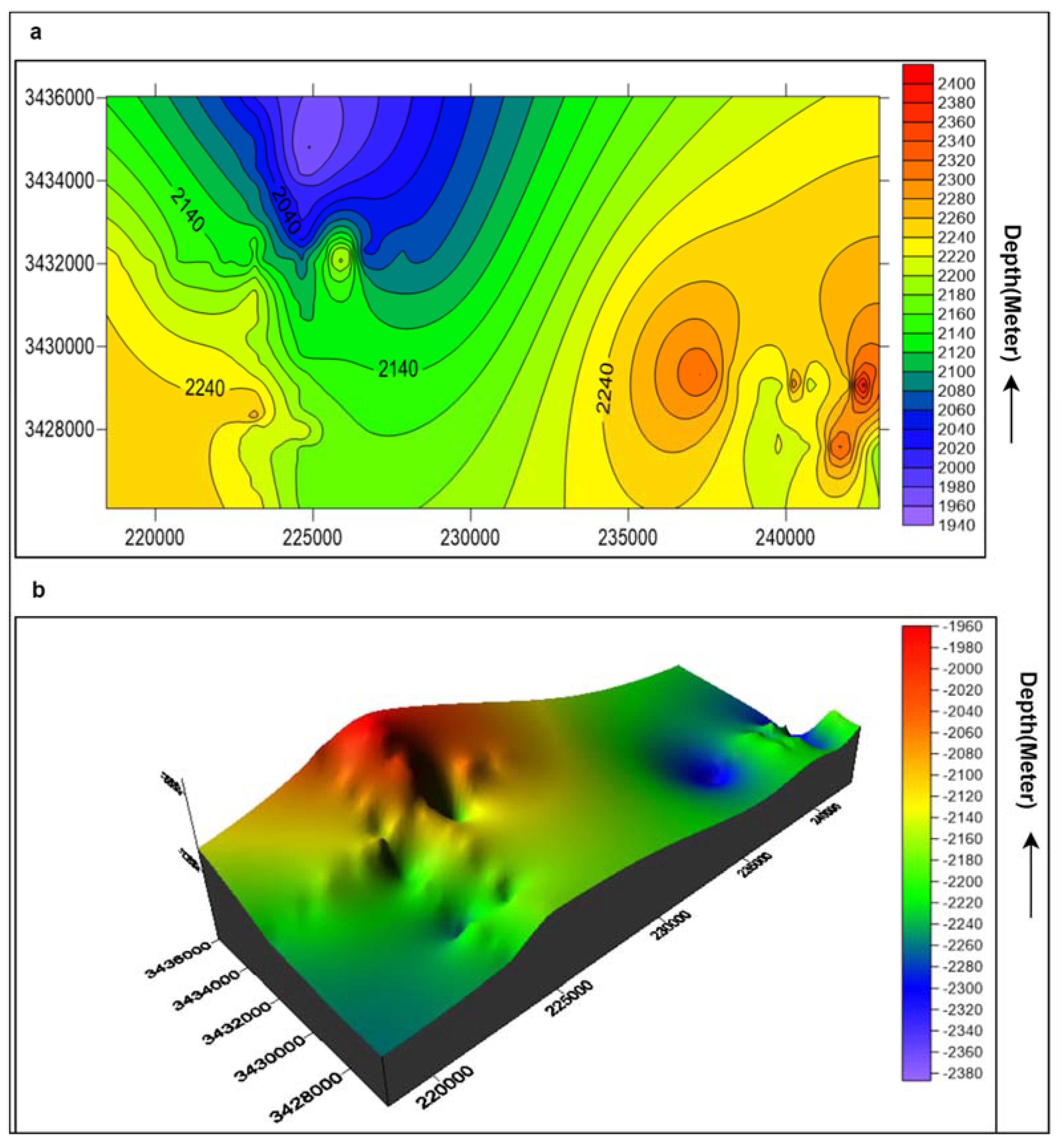
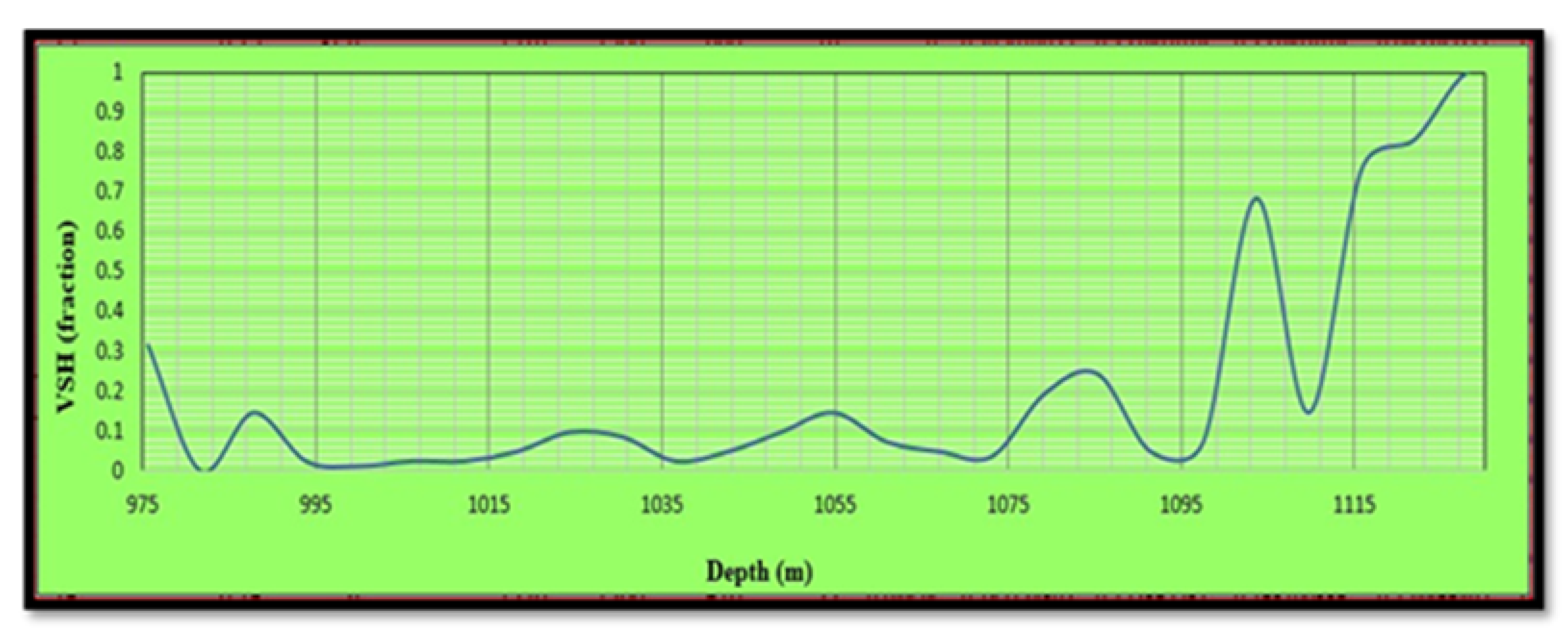


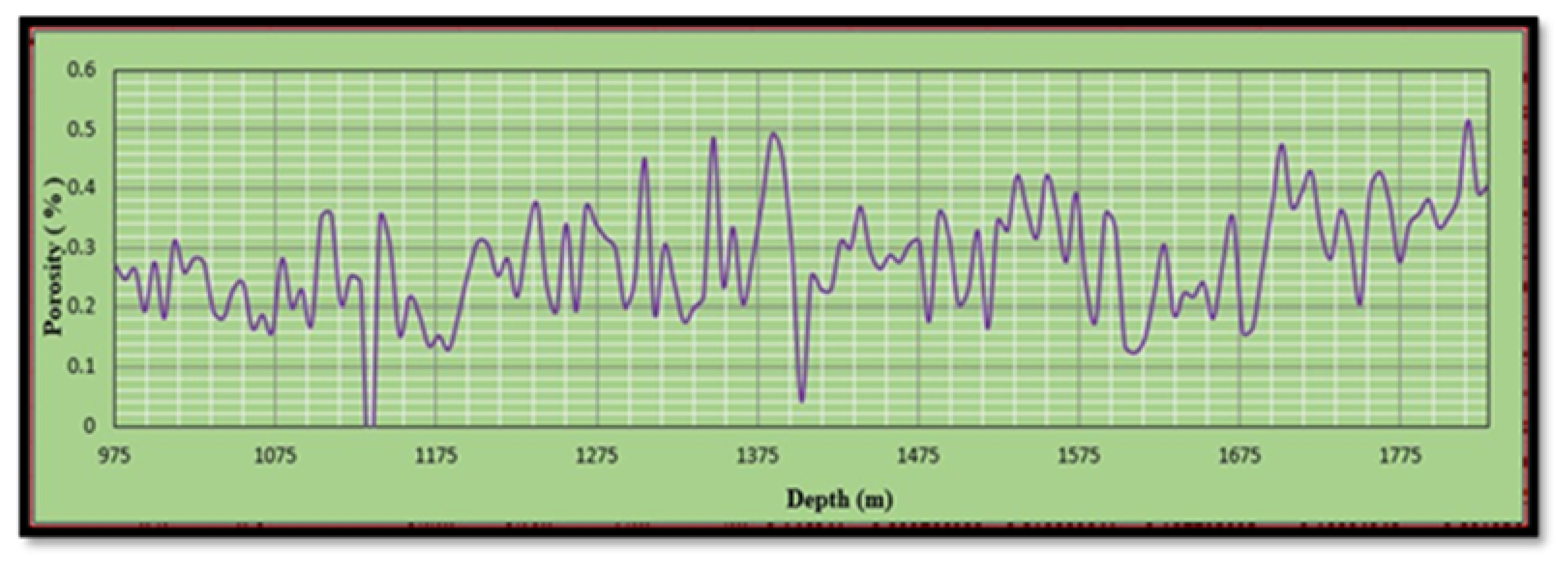
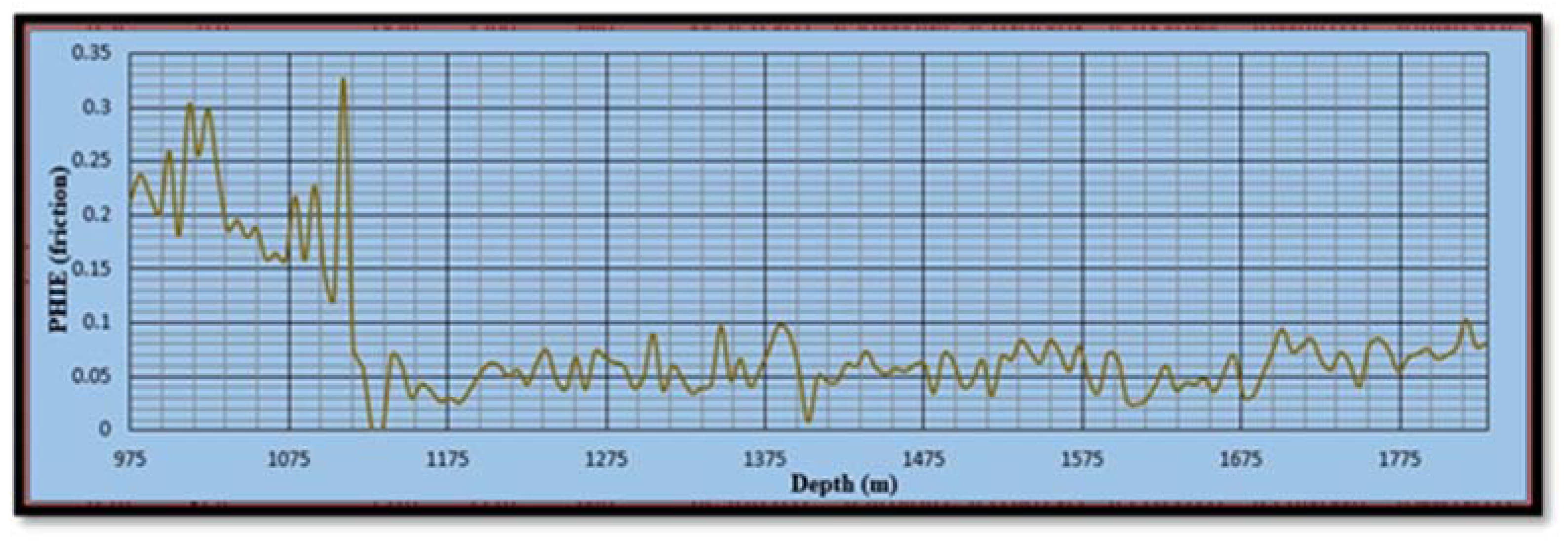
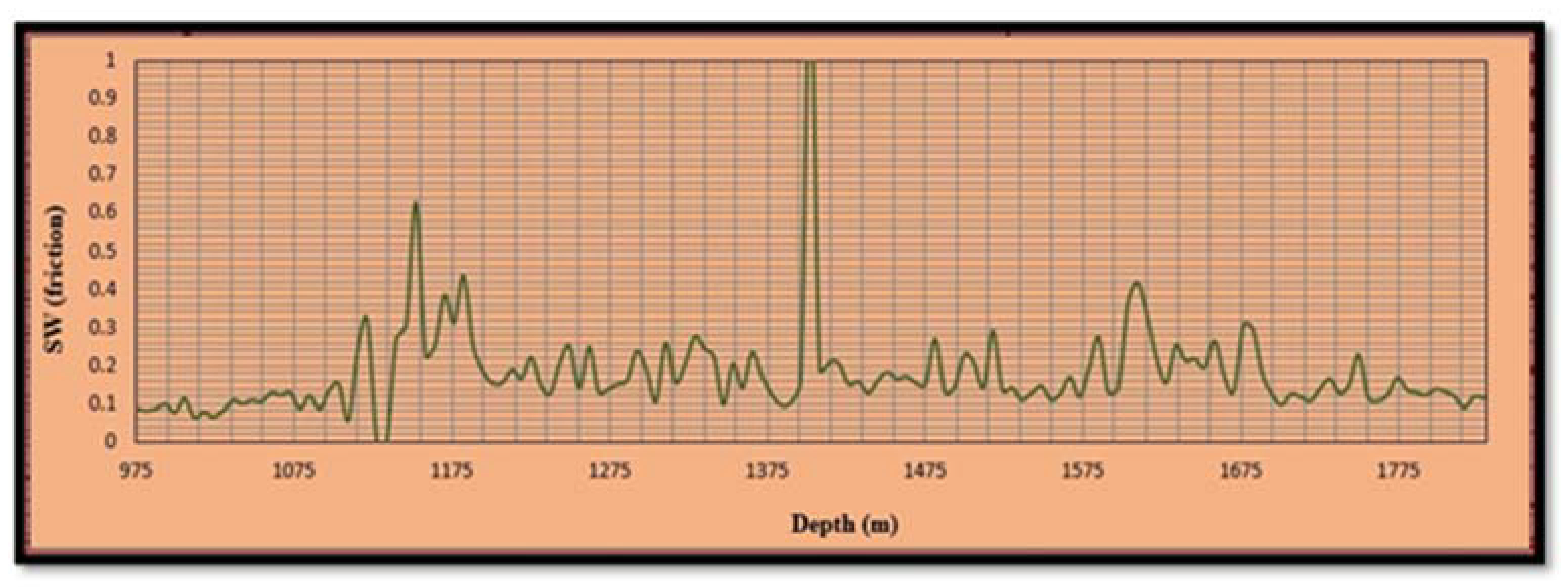

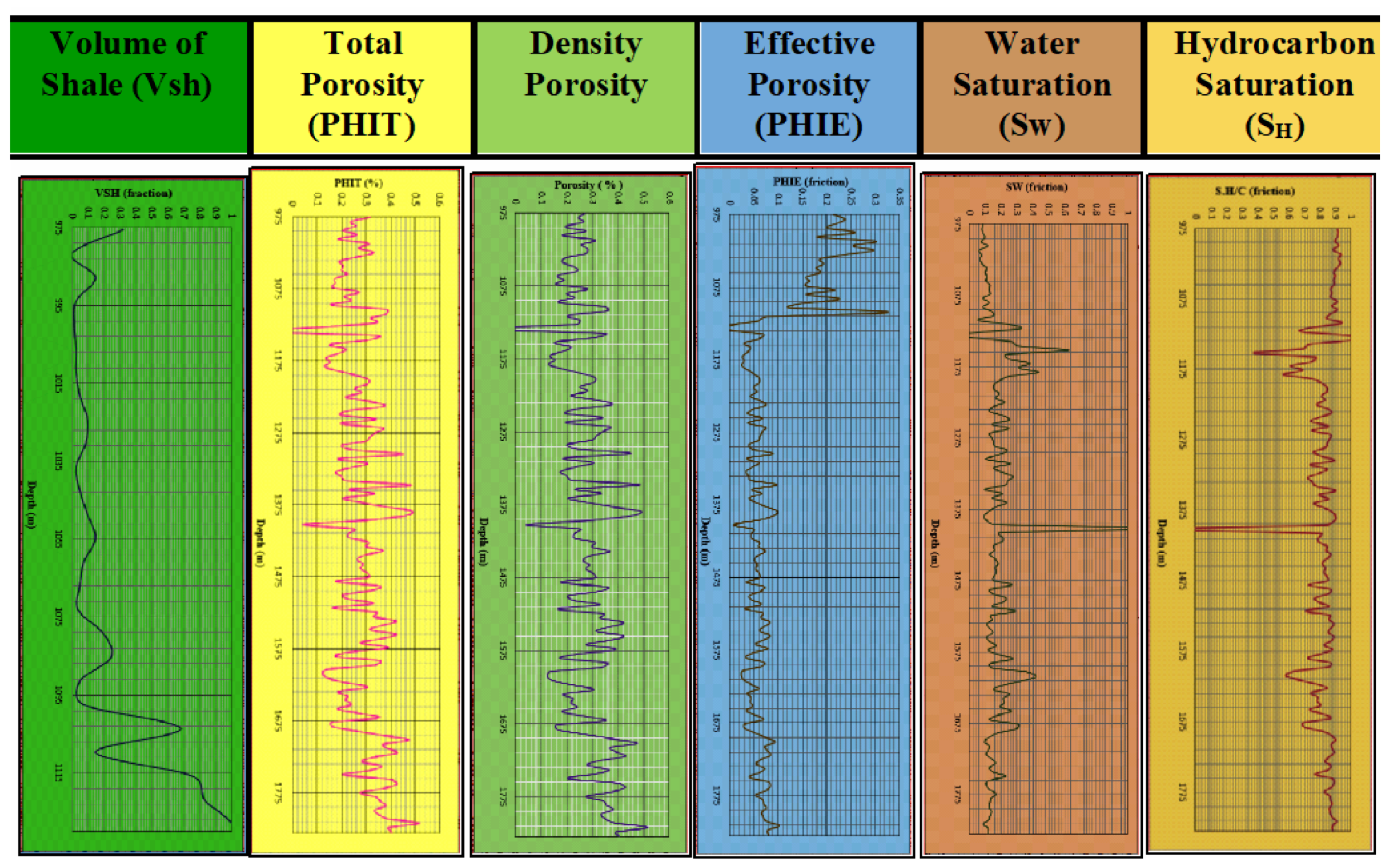
| Reference | Parameters Used | Simulation Method (2D, 3D, 4D) | Petrophysical Analysis Used (Yes/No) | Stratigraphy Interpretation Used (Yes/No) | Objective of Research Study |
|---|---|---|---|---|---|
| [11] | Volume of shale, porosity, hydrocarbon saturation, water saturation | 3D | Yes | Yes | Discovery of hydrocarbon reserve resource accumulations in Pennay field |
| [12] | Effective porosity, clay content, and water saturation | – | Yes | Yes | Proposal of joint estimation of petrophysical properties combining statistical rock physics and Bayesian seismic inversion |
| [13] | Volume | 3D | Yes | Yes | Estimation of brittleness of resource plays in 3D by integrating petrophysics and seismic data analysis |
| [14] | Joint probability function, porosity, thickness | 3D | Yes | Yes | Estimation procedure for extrapolating wireline data from existing wells using geostatistical inversion of post-stack 3D seismic data |
| [15] | Porosity, water saturation and hydrocarbon saturation | 3D | Yes | Yes | Determination of reservoir properties and estimated volume of hydrocarbons within reservoirs |
| [16] | Porosity, net-to-gross, water saturation, hydrocarbon saturation | 3D | Yes | Yes | Reserve evaluation of hydrocarbon-bearing sands |
| [17] | Volume of shale, porosity, water saturation, formation water resistivity, and hydrocarbon saturation | 2D | Yes | Yes | Structural interpretation and hydrocarbon potential of Balkassar oil field |
| [18] | Density, neutron, self-potential, and resistivity | 2D | Yes | Yes | Structural interpretation of Joya Mair oil field using 2D seismic data and petrophysical analysis |
| [19] | Porosity, permeability, moderate net to gross, and low water saturation | 3D | Yes | Yes | Application of 3D static model using 3D seismic and well log data for optimization and development of hydrocarbon potential in KN field of Niger Delta Province |
| Sr. No. | Seismic Line | Line Style | Direction |
|---|---|---|---|
| 1 | 875-KBR-230 | Strike | N-S |
| 2 | 875-KBR-229 | Strike | N-S |
| 3 | 875-KBR-231 | Dip | E-W |
| 4 | 875-KBR-221 | Dip | E-W |
| 5 | 875-KBR-220 | Dip | E-W |
| Sr. No. | Tola-01 | Unit |
|---|---|---|
| 1 | Sonic (DT) | μsec/ft |
| 2 | Neutron porosity (NPHI) | Fraction |
| 3 | Formation density (RHOB) | gm/cm3 |
| 4 | Resistivity (MSFL) (LLD) (LLS) | Ω.m |
| 5 | Gamma ray (GR) | API |
| 6 | Spontaneous potential (SP) | mV |
| 7 | Caliper (CALI) | Inches |
| Formation Name | Depth |
|---|---|
| Dunghan | 1080.46 m |
| Samana Suk | 1174.05 m |
| Datta | 1400 m |
| Warcha sandstone | 1810 m |
| Formation Name | Time |
|---|---|
| Dunghan | 0.9 s |
| Samana Suk | 0.96 s |
| Datta | 1.08 s |
| Warcha sandstone | 1.24 s |
| Formation Name | Depth |
|---|---|
| Dunghan | 1080.46 m |
| Samana Suk | 1174.05 m |
| Datta | 1400 m |
| Warcha | 1810 m |
| Petrophysical Property | Average Value |
|---|---|
| Volume of shale | 69% |
| Average porosity (PHIT) | 27.8% |
| Effective porosity (PHIE) | 8.2% |
| Water saturation (SW) | 18% |
| Density porosity | 27% |
| Hydrocarbon saturation (SH) | 82% |
Publisher’s Note: MDPI stays neutral with regard to jurisdictional claims in published maps and institutional affiliations. |
© 2021 by the authors. Licensee MDPI, Basel, Switzerland. This article is an open access article distributed under the terms and conditions of the Creative Commons Attribution (CC BY) license (http://creativecommons.org/licenses/by/4.0/).
Share and Cite
Ahmad, N.; Khan, S.; Al-Shuhail, A. Seismic Data Interpretation and Petrophysical Analysis of Kabirwala Area Tola (01) Well, Central Indus Basin, Pakistan. Appl. Sci. 2021, 11, 2911. https://doi.org/10.3390/app11072911
Ahmad N, Khan S, Al-Shuhail A. Seismic Data Interpretation and Petrophysical Analysis of Kabirwala Area Tola (01) Well, Central Indus Basin, Pakistan. Applied Sciences. 2021; 11(7):2911. https://doi.org/10.3390/app11072911
Chicago/Turabian StyleAhmad, Naveed, Sikandar Khan, and Abdullatif Al-Shuhail. 2021. "Seismic Data Interpretation and Petrophysical Analysis of Kabirwala Area Tola (01) Well, Central Indus Basin, Pakistan" Applied Sciences 11, no. 7: 2911. https://doi.org/10.3390/app11072911
APA StyleAhmad, N., Khan, S., & Al-Shuhail, A. (2021). Seismic Data Interpretation and Petrophysical Analysis of Kabirwala Area Tola (01) Well, Central Indus Basin, Pakistan. Applied Sciences, 11(7), 2911. https://doi.org/10.3390/app11072911







